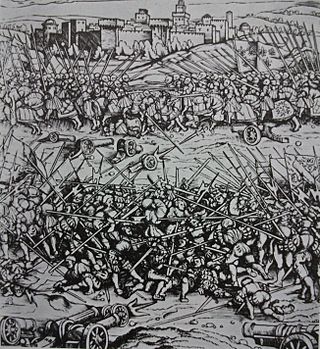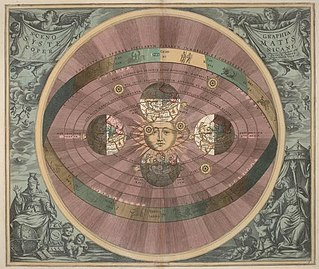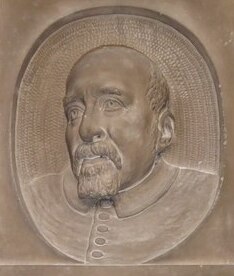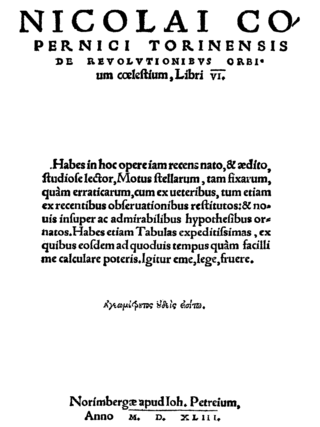Related Research Articles

Year 1512 (MDXII) was a leap year starting on Thursday of the Julian calendar.
Year 1473 (MCDLXXIII) was a common year starting on Friday of the Julian calendar.
Georg Joachim de Porris, also known as Rheticus, was a mathematician, astronomer, cartographer, navigational-instrument maker, medical practitioner, and teacher. He is perhaps best known for his trigonometric tables and as Nicolaus Copernicus's sole pupil. He facilitated the publication of his master's De revolutionibus orbium coelestium.

Georg von Peuerbach was an Austrian astronomer, poet, mathematician and instrument maker, best known for his streamlined presentation of Ptolemaic astronomy in the Theoricae Novae Planetarum. Peuerbach was instrumental in making astronomy, mathematics and literature simple and accessible for Europeans during the Renaissance and beyond.
This article contains information about the literary events and publications of 1543.

Heliocentrism is a superseded astronomical model in which the Earth and planets revolve around the Sun at the center of the universe. Historically, heliocentrism was opposed to geocentrism, which placed the Earth at the center. The notion that the Earth revolves around the Sun had been proposed as early as the third century BC by Aristarchus of Samos, who had been influenced by a concept presented by Philolaus of Croton. In the 5th century BC the Greek Philosophers Philolaus and Hicetas had the thought on different occasions that the Earth was spherical and revolving around a "mystical" central fire, and that this fire regulated the universe. In medieval Europe, however, Aristarchus' heliocentrism attracted little attention—possibly because of the loss of scientific works of the Hellenistic period.

Robert Recorde was a Welsh physician and mathematician. He invented the equals sign (=) and also introduced the pre-existing plus (+) and minus (−) signs to English speakers in 1557.

Nicolaus Copernicus was a Renaissance polymath, active as a mathematician, astronomer, and Catholic canon, who formulated a model of the universe that placed the Sun rather than Earth at its center. In all likelihood, Copernicus developed his model independently of Aristarchus of Samos, an ancient Greek astronomer who had formulated such a model some eighteen centuries earlier.
The year 1818 in science and technology involved some significant events, listed below.
The year 1774 in science and technology involved some significant events.
The year 1616 in science and technology involved some significant events.

De revolutionibus orbium coelestium is the seminal work on the heliocentric theory of the astronomer Nicolaus Copernicus (1473–1543) of the Polish Renaissance. The book, first printed in 1543 in Nuremberg, Holy Roman Empire, offered an alternative model of the universe to Ptolemy's geocentric system, which had been widely accepted since ancient times.
The year 1543 in science and technology includes the 1543 Nicolaus Copernicus publication De revolutionibus orbium coelestium often cited as the beginning of the Scientific Revolution, and also includes many other events, some of which are listed here.
The year 1506 in science and technology included many events, some of which are listed here.
The year 1500 AD in science and technology included many events, some of which are listed here.

Copernican heliocentrism is the astronomical model developed by Nicolaus Copernicus and published in 1543. This model positioned the Sun at the center of the Universe, motionless, with Earth and the other planets orbiting around it in circular paths, modified by epicycles, and at uniform speeds. The Copernican model displaced the geocentric model of Ptolemy that had prevailed for centuries, which had placed Earth at the center of the Universe.

Leopold Friedrich Prowe was a German historian and gymnasium instructor, born as the son of a town councillor of Thorn in West Prussia, the town where in 1473 the astronomer Nicolaus Copernicus was born. Prowe compiled a comprehensive German language biography of Copernicus, titled Nicolaus Coppernicus.

The relationship between science and the Catholic Church is a widely debated subject. Historically, the Catholic Church has been a patron of sciences. It has been prolific in the foundation and funding of schools, universities, and hospitals, and many clergy have been active in the sciences. Some historians of science such as Pierre Duhem credit medieval Catholic mathematicians and philosophers such as John Buridan, Nicole Oresme, and Roger Bacon as the founders of modern science. Duhem found "the mechanics and physics, of which modern times are justifiably proud, to proceed by an uninterrupted series of scarcely perceptible improvements from doctrines professed in the heart of the medieval schools." Historian John Heilbron says that "The Roman Catholic Church gave more financial and social support to the study of astronomy for over six centuries, from the recovery of ancient learning during the late Middle Ages into the Enlightenment, than any other, and probably all, other Institutions." The conflict thesis and other critiques emphasize the historical or contemporary conflict between the Catholic Church and science, citing, in particular, the trial of Galileo as evidence. For its part, the Catholic Church teaches that science and the Christian faith are complementary, as can be seen from the Catechism of the Catholic Church which states in regards to faith and science:
Though faith is above reason, there can never be any real discrepancy between faith and reason. Since the same God who reveals mysteries and infuses faith has bestowed the light of reason on the human mind, God cannot deny himself, nor can truth ever contradict truth. ... Consequently, methodical research in all branches of knowledge, provided it is carried out in a truly scientific manner and does not override moral laws, can never conflict with the faith, because the things of the world and the things of faith derive from the same God. The humble and persevering investigator of the secrets of nature is being led, as it were, by the hand of God despite himself, for it is God, the conserver of all things, who made them what they are.
The year 1588 in science and technology, Armada year, included a number of events, some of which are listed here.
The year 1558 in science and technology included a number of events, some of which are listed here.
References
- ↑ Grun, Bernard (1991). The Timetables of History (3rd ed.). New York: Simon & Schuster. p. 229. ISBN 0-671-74919-6.
- ↑ Gingerich, Owen (2004). The Book Nobody Read: Chasing the Revolutions of Nicolaus Copernicus. New York: Walker. ISBN 0-8027-1415-3.
- ↑ Koyré, Alexandre (1973). The Astronomical Revolution: Copernicus – Kepler – Borelli. Ithaca, NY: Cornell University Press. ISBN 0-8014-0504-1.
- ↑ In an appendix to Gregorius Reisch's Margarita Philosophica, published in Strasburg.
- ↑ Daumas, Maurice (1989). Scientific Instruments of the Seventeenth and Eighteenth Centuries and Their Makers. London: Portman. ISBN 978-0-7134-0727-3.
- ↑ Mills, John FitzMaurice (1983). Encyclopedia of Antique Scientific Instruments. London: Aurum Press. ISBN 0-906053-40-4.
- ↑ Johnston, Stephen (2004). "Recorde, Robert (c.1512–1558)" . Oxford Dictionary of National Biography (online ed.). Oxford University Press. doi:10.1093/ref:odnb/23241 . Retrieved 2012-01-26.(Subscription or UK public library membership required.)
- ↑ Trimble, Virginia; Williams, Thomas R.; Bracher, Katherine; Jarrell, Richard; Marché, Jordan D.; Ragep, F. Jamil (18 September 2007). Biographical Encyclopedia of Astronomers. Springer Science & Business Media. p. 339. ISBN 978-0-387-30400-7.